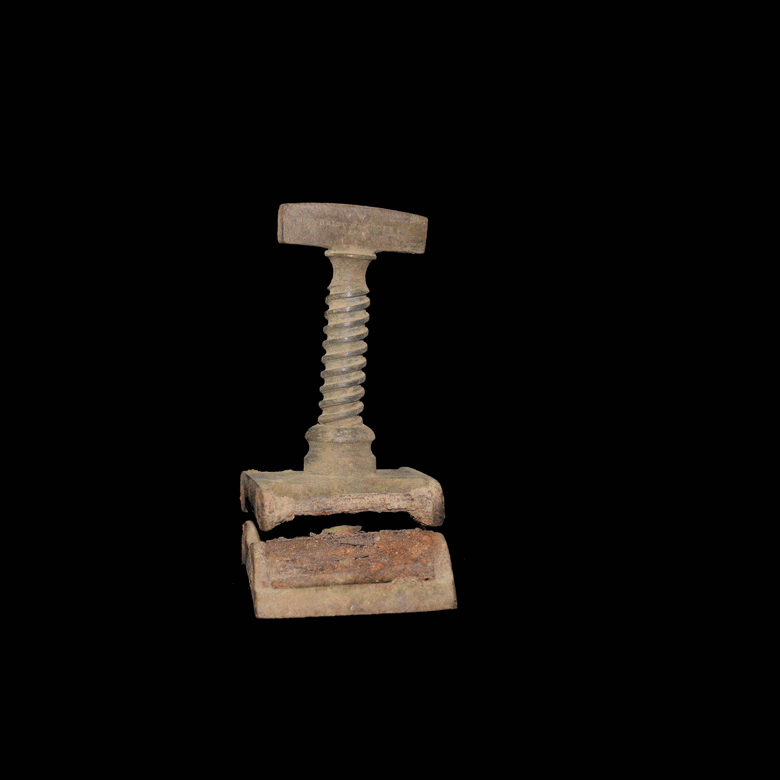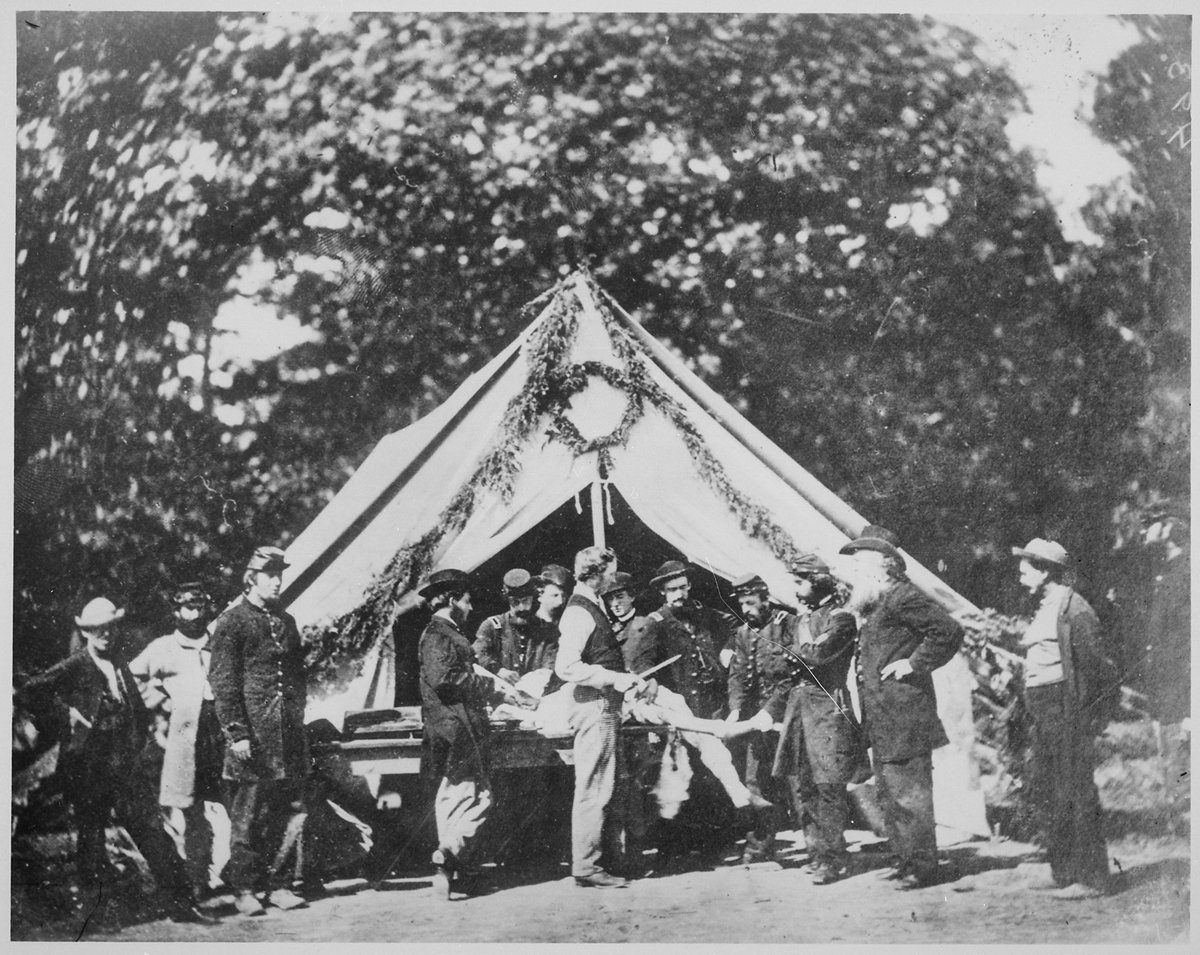Featured Fragment – Civil War-Era Tourniquet Clamp from Henrico County, Virginia
By Kerry S. González
For hundreds of years the tourniquet has been used on extremities, primarily arms and legs, in an effort to stop hemorrhaging during an amputation. For this month’s blog post we are highlighting a Civil War-era tourniquet found during a recent archaeological survey in Henrico County, Virginia. This device is composed of cast brass with “Brinkerhoff” stamped on the handle. Leather fragments, representing the no-longer-extant strap, are present as well.

Civil War-Era Tourniquet Recovered by Dovetail Staff During a Recent Archaeological Survey in Henrico County, Virginia.
Van Wyck Brinkerhoff was a minor supplier of surgical instruments and medical sets during the Civil War and the tourniquet recovered by Dovetail was likely part of a larger set which would have included a bone saw, knives, bone forceps etc. (Echols and Arbittier 2016). The surgical set shown below (missing a tourniquet and forceps) was made by Brinkerhoff between 1860 and 1862 and illustrates the number of tools needed to perform an amputation.
According to Robert L. Mabry’s article, Tourniquet Use on the Battlefield (2006), the tourniquet is fundamentally unchanged from its original form when it was first used on the battlefield in 1674 (Mabry 2006). However, prior to this, Hans Von Gersdoff, a German surgeon, was a proponent for the use of tight bands around an amputation site, as illustrated in his book Feldtbuch der Wundtartzney (Field Book of Surgery) published in 1517 (Mabry 2006). Over the years, the tourniquet evolved as surgeons tried to find safer and more effective ways to reduce blood flow during an amputation while at the same time reducing the risk of causing nerve or tissue damage to the limb. In 1718 Jean Louis Petit created a tourniquet which included a strap and a screw device, similar to the one recovered by Dovetail, which could be tightened around the appendage thus negating the need for an assistant to hold the tourniquet in place (Welling and Rich 2012).
During the Civil War amputations were a common procedure as the Minié Ball, a widely-used bullet in rifles during the war, caused terrible damage to the body. An 1879 description gives grim details of the extent of the damages caused by these projectiles: “bones are ground almost to power muscles, ligaments, and tendons torn away, and the parts otherwise so mutilated, that loss of life, certainly of limb, is almost an inevitable consequence” (Helmuth 1879).
Approximately 60,000 amputations were performed during the Civil War, some done with no anesthesia (U.S. Library of Medicine 2013). This left soldiers fearful of the surgeons, especially the younger, more inexperienced doctors who were overly enthusiastic to perform amputations. These zealous surgeons, nicknamed “butchers” by the soldiers, were sometimes criticized by the more experienced doctors and were accused of using the battlefield as a way to improve their skills instead of having the patient’s best interest in mind (U.S. Library of Medicine 2013).
Unfortunately, many amputations during the Civil War resulted in infection from lack of sterilization which inevitably lead to death. Tourniquets continued to be used on and off the battlefield to help stop the flow of blood on an open wound or to perform an amputation. A historical account from World War II states that, once again, tourniquets were being misused, sometimes resulting in unnecessary amputation. “Soldiers—whether medical or non-medical—regularly misused tourniquets. They applied them unnecessarily; left them unloosened for too long; and occasionally evacuated patients with tourniquets concealed by blankets or clothing, and hence not discovered until the limb was doomed” (Welling and Rich 2012). A modern version of the tourniquet is still used today but with much greater care and awareness on the part of the medical professional administering the device.
Any distributions of blog content, including text or images, should reference this blog in full citation. Data contained herein is the property of Dovetail Cultural Resource Group and its affiliates.
References:
Echols, Michael, and Doug Arbittier
2014 Archaeological Data Recovery Plan: Site 31Rd1426, Randolph County, North Carolina. North Carolina Department of Transportation Human Environment Section, Raleigh, North Carolina.
Helmuth, William Tod
1879 A System of Surgery. Hahnemann Publishing House, Philadelphia, Pennsylvania.
Mabry, Robert
2006 Tourniquet Use on the Battlefield. Electronic document, https://academic.oup.com/milmed/article/171/5/352/4577893, accessed May 2018.
Medical and Surgical Antiques
n.d. The Civil War Period Amputation and Surgical Sets Collection. Electronic document, https://medicalandsurgicalantiques.com/the-civil-war-period-collection.html, accessed May 2018.
Tipton, W.H.
1868–1925 Amputation Being Performed in a Hospital Tent, Gettysburg. Glass Negatives of ‘Tipton’s Photographic Views of the Battle of Gettysburg and other Photographs of General Interest”, 1868–1925. Available online https://catalog.archives.gov/id/520201, accessed May 2018.
U.S. Library of Medicine
2013 Maimed Men. Electronic document, https://www.nlm.nih.gov/exhibition/lifeandlimb/maimedmen.html, accessed May 2018.
Welling, David R., and Norman M. Rich
2012 A Brief History of the Tourniquet. Electronic document, https://www.jvascsurg.org/article/S0741-5214(11)02470-0/pdf?code=ymva-site, accessed May 2018.


